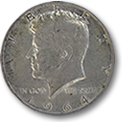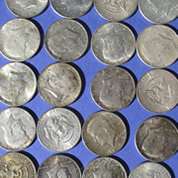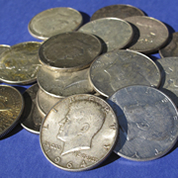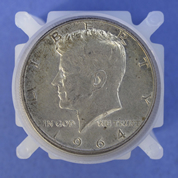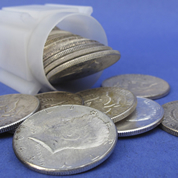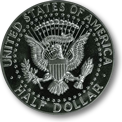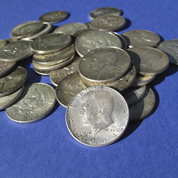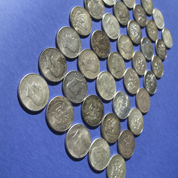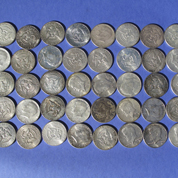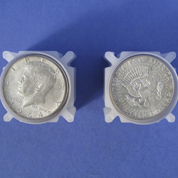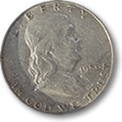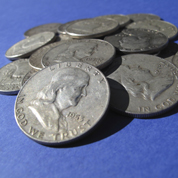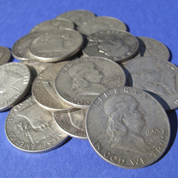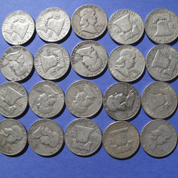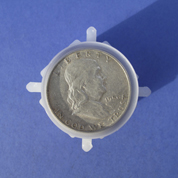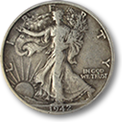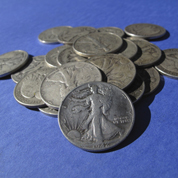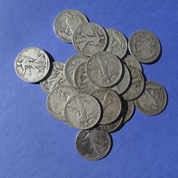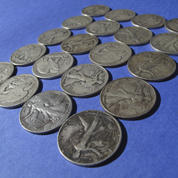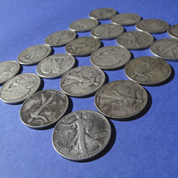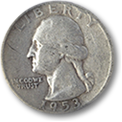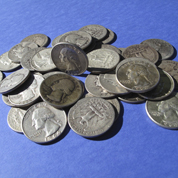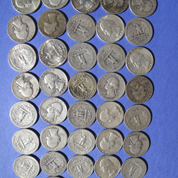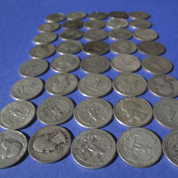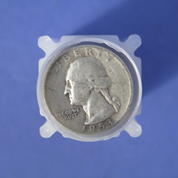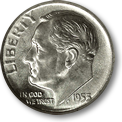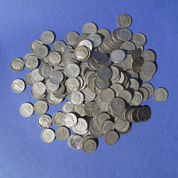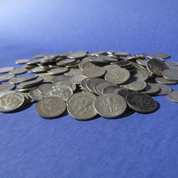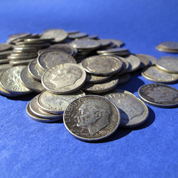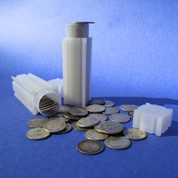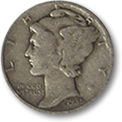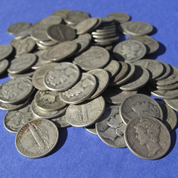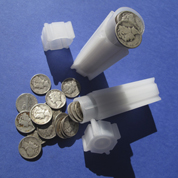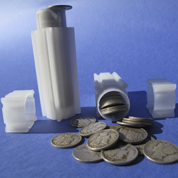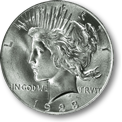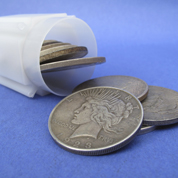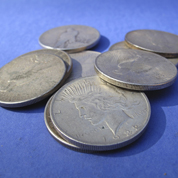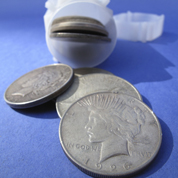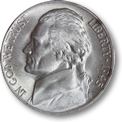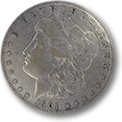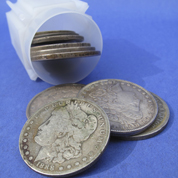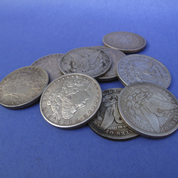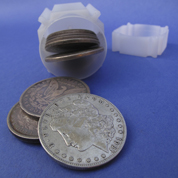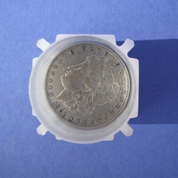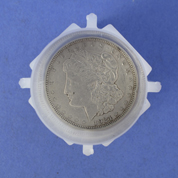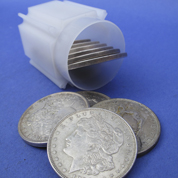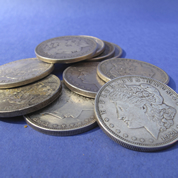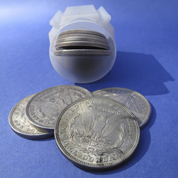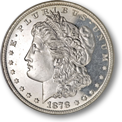Junk Silver Products
When the 40 percent silver halves were released in 1965, hoarding continued. Every time the Kennedy Half was released, it was hoarded out of circulation, causing a need to produce more coins due to the shortage of half dollars. More coins had to be produced to equal the need for coinage. A total of 295,046,978 of 40 percent junk silver coins were produced between Philadelphia and Denver Mint Departments and even though the copper-nickel metal values did equate in value at the time, silver was simply more popular. The 40 percent silver coins disappeared from circulation almost as quickly. The ratio of 40 percent silver was minted until 1970 when the metals changed to only copper-nickel combinations.At the same time the silver in the Kennedy Halves was being reduced to 40 percent, the silver content from the dime and the nickel was being eliminated altogether. This only caused more problems. It made the 40 percent silver half the only coin with silver available, and this only worked to increase its perceived higher value. For the collector, however, this served to lower the value of the 40 percent half. Since there was no mint-mark, collectors had no way to tell which city or center actually minted them, and this caused the collectors of that time to almost ignore them.
The first minting of this commemoration coin held 90 percent silver. This practice was ended in 1964. This caused a hoarding of this famous half dollar. The silver content then went down to 40 percent and gradually the silver content was eliminated over time. Today no silver is found in our half dollars in circulation.
Historic records indicate this hoarding was instigated by people who deeply loved Kennedy, and felt this coin ownership represented a piece of American history. This belief included the sentiment that this coin held an inherent increased value. This became a popular thought; to pass a piece of history down through our American family system. Also, the value of gold and silver were once again on the rise, and hoarding to secure the metal value seemed wise and important at that time.
Today these coins are minted from copper and nickel. They are no longer circulated widely, and the most common place to find them is on a gaming table or in a slot machine win or raking at a local casino. Currently the casino systems are switching over to vouchers and notes so this, too, will become an unavailable source. There were also releases of proofs of Kennedy Half Dollars for collectors and heritage protectors. The proof sets are highly sought after for collectible coins.
Issued in 1943, the Franklin Half was circulated until 1963. The desire to honor Benjamin Franklin on a coin began with U.S. Treasury Mint Director Nellie Tayloe Ross. Respected not only for his role as a founding father, Franklin received many accolades for his contributions as a writer, printer, inventor and scientist. The project began in 1947 when Ross commissioned Mint Chief Engraver John R. Sinnock to begin making designs for the half dollar coin. Sinnock had begun his initial drawings before the formal request was initiated, and he died before the coins had been cast into molds.
The new Mint Chief Engraver assigned to the project was Gilroy Roberts. Roberts inherited the task of adding an eagle which is a mandatory part of U.S. Mint coin design since the Coinage Act of 1873. Roberts included an unusually small eagle and added the crack that exists in the Liberty Bell. The office of the U.S. Mint then submitted the coin designs to the Commission of Fine Arts, who rejected the idea of displaying a crack in the liberty bell, and disliked how small the eagle was. The fear from the commission was that design details would invoke ridicule and fuel jokes. The Mint officials and the Treasury Department officials ignored the review and proceeded with Roberts and Sinnock's designs.
Today, the walking liberty coins are highly prized because of their inherent silver content. They were made with 90 percent silver and 10 percent copper. Coin dealers and precious metals dealers call them junk silver if they have no unique numismatic value. Junk silver is regularly traded as a hedge against inflation, a way to hold value, and something that can be used for bartering in bad economic times. Learning of the histories and climates that surround our nation's currency is a deeply layered project, with much to teach us about our evolution, values and accomplishments as a nation. Coin collecting is not only a profitable and pleasurable process, it can also teach us much about our people and our past. Patriotism and the greatly symbolic images used were powerful, and people were definitely impacted when they were released into circulation.
Finally, the new silver Washington quarter coin was released on August 1, 1932, and we have been using it ever since. Many continued to believe that Laura Frasier should have gotten this contract for her stunning design, and 33 years after her death, she was honored when her Washington design was chosen to augment one side of the 1999 commemorative Half Eagle, a five dollar gold coin created for another commemoration of 200 years after the death of George Washington. Frasier and her husband were able to go down in history as the talented couple responsible for some of our most beloved designs with some still in circulation today.
The design Flannagan created had a simplicity more appropriate to a portrait than metal art. It had an extraordinarily low relief. Washington's bust faces left, dominating the obverse while the date is below, and LIBERTY reads above. IN GOD WE TRUST is etched into the left field while the designer's initials can be found on the base of his neck. A heralding spread winged eagle graces the reverse with the words "E PLURIBIS UNUM" above with "Quarter Dollar" and a wreath underneath. The mint marks that can be found below the wreath are on the 90 percent silver coins dated 1964 and earlier and later non-silver coins from 1968 have it just to the right of Washington's ribbon.
The Roosevelt dime remains the only US minted coin in circulation ever to receive a "W" mintmark since all others were only part of specially produced mint and proof sets. Since it is a circulation issue coin, higher values can actually still be found in the mint sets and proof sets. A mint-set retails for $10 while the '96-W proof goes for $25. The rarest of the entire Roosevelt series, the uncirculated proof; the 1949-S, is worth more than its silver bullion value, and in its mint condition retails for just $45. To check for wear on one of these coins, see the high-points in FDR's hair, cheek, and flame, and on the horizontal bands of the torch.
The Mercury dimes are still considered to be the most beautifully crafted and their run contained the early and first 90 percent silver for all the dates and versions of that particular dime. The older, more classic dimes featured the seated Lady Liberty and the Barber dimes.
Because of the design impressiveness, the Mercury Dime proofs are exquisite. Only produced for seven years, a complete proof set in PR-65 condition goes for about $5000. Those who choose to collect the historic coins of our nation become part of the long history of American currency, financial development, artistic expression and political will.
Today, the mercury dime is most valued as a hedge against inflation because of its intrinsic silver content. These junk silver dimes are commonly traded as silver bullion, usually slightly below their silver value.
The end of the silver Peace Dollar run was as equally and ominously as symbolic as its birth. In 1939 World War II erupted in Europe. The design came close to having another run in 1964 when Congress wanted to help supply Nevada casinos with more silver coins. 45 million coins were authorized for production as the smaller silver coins were quickly disappearing. Many saw this move as a way to serve special interests, and after the Denver Mint had produced 316,076 Peace Dollars dated 1964, in 1965 president Johnson then rescinded the order. Even though all the coins were supposed to be recalled and melted, rumors persist today of some of them surviving.
Collectors who understand and track the historical information that is available by reviewing the circulation runs and political motivations of the US Treasury Department, not only obtain valuable collection information. These folks also learn previously un-released histories our nation has been perhaps reluctant to release more publicly due to its un-popular nature. It is for the benefit of the common American people. Popular public demand has a huge impact on the decision makers of our nation. For a collector of US American coins, this can be an advantage. As a collector, be sure to make your voice heard when working to improve the political conditions of the common business venture, that serves to support the economic reality of our American people and families.
It pays off to look into and discover the histories of different coins minted into circulation. It certainly does give an advantage to anyone who is doing serious coin collecting. Having historical facts about release numbers, die stamp errors and counterfeit coinage released into circulation makes a big difference when calculating value, and making decisions about which series or which proof sets to spend precious time collecting and assembling. Collecting with family members can be an exceptional way to create a valuable family hobby that everyone can enjoy, and having more eyes and fingers assessing the latest pocketful of coins from any market, can sometimes bear a most unusual kind of fruit.
Today, silver war nickels are often traded as simply junk silver coins. This status basically gives them no significant numismatic value, with their value by precious metals dealers being simply the value of the inherent metal content. The silver inside the junk coins is what is valuable. However, the addition of the manganese metal makes it more costly to melt and extract pure silver metal than other junk silver coins such as pre 1965 dimes, quarters, and halves. For this reason, the junk silver war nickels are traded at a price considerably lower than their inherent metal content. For reference, the junk silver dimes, quarters, and halves generally trade around the price of spot silver. Anyway, the nostalgia surrounding the silver war nickels makes them a unique item worthy of collecting and storing.
The 140,000 kg of monthly production and silver purchases were believed by supporters to relieve the nation's farmers and interests in the silver mining industries in a manner that would result in an inflation that would help relieve the financial stress they were currently under. They believed large purchases of silver would raise the market price of silver, thus increasing profits. Even though the Act required large silver purchases, it only required coinage of 2,000,000 silver dollars per month and only until 1891. The Treasury already had surpluses of silver. So, in 1892, production of silver dollars began to drop sharply.
By 1892 the remaining silver was turned into half dollars, dimes and quarters. In the early part of 1893 industrial companies such as the Reading and the Philadelphia Railroads and the National Cordage Company announced bankruptcy. The resulting failures and bank runs that occurred became known as the "Panic of 1893." President Grover Cleveland believed the panic was caused by the Purchase Act. A special congressional session was called. This act was repealed on November 1, 1893.
In 1898 A Bill was again approved in Congress that required any left over bullion from the Sherman Silver Purchase Act get re-cast back into silver coinage, and production rose again. In 1904 these silver stocks were completely gone. All Mint Departments stopped producing the Morgan Dollar.
With no mint-mark at all the coin's value runs around $24 to $1000 (in 2009) depending on its quality. The "D" mint-mark coins go for $38 to $1300. The "S" starts at $34 and soars to $9000. The coin had 44,690,000 circulation strikes. There were 250 proofs sets made. Its PCGS numbers include 7296, 7297, 9729, 7342. The coin is 38.1 millimeters in diameter, and weighs 26.73 grams. The coin has reeded edges, no mint-mark if struck in Philadelphia, otherwise the mark shows up on its reverse below the center of the wreath.
To collectors this coin is better than junk silver bullion coins or silver bullion bars. This is due to not only its scarcity but also for its numismatic value. It can be found at low costs even though it remains harder to find than the Peace Dollar. This level of scarcity adds to its leverage when prices of silver begin to rise. It is not like other bullion coins since it is exempt from broker reporting and government confiscation due to the status as a scarce and collectible item. They are also admired for the instant worldwide liquidity that they offer.
Buy Now!
Call: --- or
Email: sales@junksilver.com
Sell your junk Silver here.
Live Buy Prices
Live Sell Prices
Call: --- or
Email: sales@junksilver.com
Sell your junk Silver here.
Live Buy Prices
Live Sell Prices







